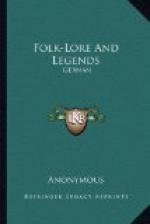blasted, sometimes of a deep green hue, and within
which it is dangerous to sleep, or to be found after
sunset. The removal of those large portions of
turf, which thunderbolts sometimes scoop out of the
ground with singular regularity, is also ascribed
to their agency. Cattle which are suddenly seized
with the cramp, or some similar disorder, are said
to be elf-shot, and the approved cure is to chafe
the parts affected with a blue bonnet, which, it may
be readily believed, often restores the circulation.
The triangular flints frequently found in Scotland,
with which the ancient inhabitants probably barbed
their shafts, are supposed to be the weapons of fairy
resentment, and are termed elf arrowheads. The
rude brazen battle-axes of the ancients, commonly
called “celts,” are also ascribed to their
manufacture. But, like the Gothic duergar, their
skill is not confined to the fabrication of arms;
for they are heard sedulously hammering in linns,
precipices, and rocky or cavernous situations, where,
like the dwarfs of the mines mentioned by George Agricola,
they busy themselves in imitating the actions and
the various employments of men. The Brook of
Beaumont, for example, which passes in its course by
numerous linns and caverns, is notorious for being
haunted by the fairies; and the perforated and rounded
stones which are formed by trituration in its channels
are termed by the vulgar fairy cups and dishes.
A beautiful reason is assigned by Fletcher for the
fays frequenting streams and fountains. He tells
us of
“A virtuous well, about whose
flowery banks
The nimble-footed fairies dance
their rounds
By the pale moonshine, dipping oftentimes
Their stolen children, so to make
them free
From dying flesh and dull mortality.”
It is sometimes accounted unlucky to pass such places
without performing some ceremony to avert the displeasure
of the elves. There is upon the top of Minchmuir,
a mountain in Peeblesshire, a spring called the Cheese
Well, because, anciently, those who passed that way
were wont to throw into it a piece of cheese as an
offering to the fairies, to whom it was consecrated.
Like the feld elfen of the Saxons, the usual
dress of the fairies is green; though, on the moors,
they have been sometimes observed in heath-brown,
or in weeds dyed with the stone-raw or lichen.
They often ride in invisible procession, when their
presence is discovered by the shrill ringing of their
bridles. On these occasions they sometimes borrow
mortal steeds, and when such are found at morning,
panting and fatigued in their stalls, with their manes
and tails dishevelled and entangled, the grooms, I
presume, often find this a convenient excuse for their
situation, as the common belief of the elves quaffing
the choicest liquors in the cellars of the rich might
occasionally cloak the delinquencies of an unfaithful
butler.




